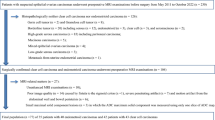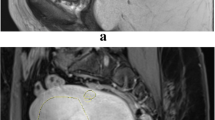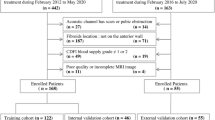Abstract
Purpose
To investigate the impact of applying three different volume of interests (VOIs) in ADC map-based radiomic analysis and compare their diagnostic performance in the differentiation of uterine sarcoma and atypical leiomyoma.
Procedures
Seventy-eight patients (29 uterine sarcomas, 49 uterine leiomyomas) imaged with pelvic magnetic resonance imaging (MRI) prior to surgery were included in this retrospective study. Manually, segmentations of VOIs covered three different regions on apparent diffusion coefficient (ADC) maps: (1) tumor, (2) tumor and small piece of surrounded tissue, and (3) whole uterus. Texture and non-texture features were extracted from each VOI. The 0.623 + bootstrap method and the area under the receiver-operating characteristic curve (AUC) were used to select the features. Twenty logistic regression models (orders of 1–20) based on different combination of image features were built for each way of image segmentation.
Results
For the first VOI region, model 18 with 18 features yielded the highest AUC of 0.830, sensitivity of 76.0 %, specificity of 73.2 %, and accuracy of 73.9 %. For the second VOI region, model 17 with 17 features yielded the highest AUC of 0.853, sensitivity of 75.5 %, specificity of 75.5 %, and accuracy of 76.8 %. For the third VOI region, model 20 with 20 features yielded the highest AUC of 0.876, sensitivity of 76.3 %, specificity of 84.5 %, and accuracy of 82.4 %.
Conclusions
Radiomic model based on features extracted from VOI that covered the whole uterus had the best diagnostic performance. Adopting VOI contained more image information that was useful in improving diagnostic performance of radiomic model.




Similar content being viewed by others
References
Gadducci A, Cosio S, Romanini A, Genazzani AR (2008) The management of patients with uterine sarcoma: a debated clinical challenge. Crit Rev Oncol Hematol 65:129–142
Amant F, Coosemans A, Debiec-Rychter M, Timmerman D, Vergote I (2009) Clinical management of uterine sarcomas. Lancet Oncol 10:1188–1198
Pietzner K, Buttmann-Schweiger N, Sehouli J, Kraywinkel K (2018) Incidence patterns and survival of gynecological sarcoma in Germany: analysis of population-based Cancer registry data on 1066 women. Int J Gynecol Cancer 28:134–138
Owen C, Armstrong AY (2015) Clinical management of leiomyoma. Obstet Gynecol Clin N Am 42:67–85
Kim TH, Kim JW, Kim SY, Kim SH, Cho JY (2018) What MRI features suspect malignant pure mesenchymal uterine tumors rather than uterine leiomyoma with cystic degeneration? J Gynecol Oncol 29:e26
Guo-Fu Z, He Z, Xiao-Mei T, Hao Z (2014) Magnetic resonance and diffusion-weighted imaging in categorization of uterine sarcomas: correlation with pathological findings. Clin Imaging 38:836–844
Namimoto T, Yamashita Y, Awai K, Nakaura T, Yanaga Y, Hirai T, Saito T, Katabuchi H (2009) Combined use of T2-weighted and diffusion-weighted 3-T MR imaging for differentiating uterine sarcomas from benign leiomyomas. Eur Radiol 19:2756–2764
de Leon AD, Kapur P, Pedrosa I (2019) Radiomics in kidney Cancer: MR imaging. Magn Reson Imaging Clin N Am 27:1–13
Lambin P, Leijenaar RTH, Deist TM, Peerlings J, de Jong EEC, van Timmeren J, Sanduleanu S, Larue RTHM, Even AJG, Jochems A, van Wijk Y, Woodruff H, van Soest J, Lustberg T, Roelofs E, van Elmpt W, Dekker A, Mottaghy FM, Wildberger JE, Walsh S (2017) Radiomics: the bridge between medical imaging and personalized medicine. Nat Rev Clin Oncol 14:749–762
Lambin P, Rios-Velazquez E, Leijenaar R, Carvalho S, van Stiphout RGPM, Granton P, Zegers CML, Gillies R, Boellard R, Dekker A, Aerts HJWL (2012) Radiomics: extracting more information from medical images using advanced feature analysis. Eur J Cancer 48:441–446
Gillies RJ, Kinahan PE, Hricak H (2016) Radiomics: images are more than pictures, they are data. Radiology 278:563–577
Gevaert O, Mitchell LA, Achrol AS, Xu J, Echegaray S, Steinberg GK, Cheshier SH, Napel S, Zaharchuk G, Plevritis SK (2014) Glioblastoma multiforme: exploratory radiogenomic analysis by using quantitative image features. Radiology 273:168–174
Prasanna P, Patel J, Partovi S, Madabhushi A, Tiwari P (2017) Radiomic features from the peritumoral brain parenchyma on treatment-naive multi-parametric MR imaging predict long versus short-term survival in glioblastoma multiforme: preliminary findings. Eur Radiol 27:4188–4197
Shen C, Liu Z, Guan M, Song J, Lian Y, Wang S, Tang Z, Dong D, Kong L, Wang M, Shi D, Tian J (2017) 2D and 3D CT Radiomics features prognostic performance comparison in non-small cell lung Cancer. Transl Oncol 10:886–894
Li H, Zhu Y, Burnside ES, Drukker K, Hoadley KA, Fan C, Conzen SD, Whitman GJ, Sutton EJ, Net JM, Ganott M, Huang E, Morris EA, Perou CM, Ji Y, Giger ML (2016) MR imaging Radiomics signatures for predicting the risk of breast Cancer recurrence as given by research versions of MammaPrint, Oncotype DX, and PAM50 gene assays. Radiology 281:382–391
Wibmer A, Hricak H, Gondo T, Matsumoto K, Veeraraghavan H, Fehr D, Zheng J, Goldman D, Moskowitz C, Fine SW, Reuter VE, Eastham J, Sala E, Vargas HA (2015) Haralick texture analysis of prostate MRI: utility for differentiating non-cancerous prostate from prostate cancer and differentiating prostate cancers with different Gleason scores. Eur Radiol 25:2840–2850
Lerski RA, Straughan K, Schad LR, Boyce D, Bluml S, Zuna I (1993) MR image texture analysis--an approach to tissue characterization. Magn Reson Imaging 11:873–887
Kotrotsou A, Zinn PO, Colen RR (2016) Radiomics in brain tumors: An Emerging Technique for Characterization of Tumor Environment. Magn Reson Imaging 24:719–729
Lakhman Y, Veeraraghavan H, Chaim J, Feier D, Goldman DA, Moskowitz CS, Nougaret S, Sosa RE, Vargas HA, Soslow RA, Abu-Rustum NR, Hricak H, Sala E (2017) Differentiation of uterine Leiomyosarcoma from atypical leiomyoma: diagnostic accuracy of qualitative MR imaging features and feasibility of texture analysis. Eur Radiol 27:2903–2915
Kumar V, Gu Y, Basu S, Berglund A, Eschrich SA, Schabath MB, Forster K, Aerts HJWL, Dekker A, Fenstermacher D, Goldgof DB, Hall LO, Lambin P, Balagurunathan Y, Gatenby RA, Gillies RJ (2012) Radiomics: the process and the challenges. Magn Reson Imaging 30:1234–1248
Kotrotsou A, Zinn P, Colen R (2015) Introduction to texture analysis for brain tumors: concept and clinical relevance [abstract]. American Society of Neuroradiology 53rd Annual Meeting
Tanos V, Berry KE (2018) Benign and malignant pathology of the uterus. Best Pract Res Clin Obstet Gynaecol 46:12–30
Sahdev A, Sohaib SA, Jacobs I, Shepherd JH, Oram DH, Reznek RH (2001) MR imaging of uterine sarcomas. AJR Am J Roentgenol 177:1307–1311
Bi Q, Xiao Z, Lv F, Liu Y, Zou C, Shen Y (2018) Utility of clinical parameters and multiparametric MRI as predictive factors for differentiating uterine sarcoma from atypical leiomyoma. Acad Radiol 25:993–1002
Vallieres M, Freeman CR, Skamene SR, El Naqa I (2015) A radiomics model from joint FDG-PET and MRI texture features for the prediction of lung metastases in soft-tissue sarcomas of the extremities. Phys Med Biol 60:5471–5496
Zhou H, Vallieres M, Bai HX et al (2017) MRI features predict survival and molecular markers in diffuse lower-grade gliomas. Neuro-Oncology 19:862–870
Dong Y, Feng Q, Yang W, Lu Z, Deng C, Zhang L, Lian Z, Liu J, Luo X, Pei S, Mo X, Huang W, Liang C, Zhang B, Zhang S (2018) Preoperative prediction of sentinel lymph node metastasis in breast cancer based on radiomics of T2-weighted fat-suppression and diffusion-weighted MRI. Eur Radiol 28:582–591
Zou KH, Warfield SK, Bharatha A, Tempany CMC, Kaus MR, Haker SJ, Wells WM III, Jolesz FA, Kikinis R (2004) Statistical validation of image segmentation quality based on a spatial overlap index. Acad Radiol 11:178–189
Chen Y, Chen TW, Wu CQ, Lin Q, Hu R, Xie CL, Zuo HD, Wu JL, Mu QW, Fu QS, Yang GQ, Zhang XM (2018) Radiomics model of contrast-enhanced computed tomography for predicting the recurrence of acute pancreatitis. Eur Radiol. https://doi.org/10.1007/s00330-018-5824-1
Tanadini-Lang S, Bogowicz M, Veit-Haibach P, Huellner M, Pauli C, Shukla V, Guckenberger M, Riesterer O (2018) Exploratory Radiomics in computed tomography perfusion of prostate Cancer. Anticancer Res 38:685–690
Nekooeimehr I, Lai-Yuen S, Bao P et al (2016) Automated tracking, segmentation and trajectory classification of pelvic organs on dynamic MRI. Conf Proc IEEE Eng Med Biol Soc 2016:2403–2406
Colen R, Hatami M, Kotrotsou A et al (2015) NIMG-11: radiomic subclassification of glioblastoma. Neuro Oncol 17:v155–v155
Malayeri AA, El Khouli RH, Zaheer A et al (2011) Principles and applications of diffusion-weighted imaging in cancer detection, staging, and treatment follow-up. Radiographics 31:1773–1791
Gerges L, Popiolek D, Rosenkrantz AB (2018) Explorative investigation of whole-lesion histogram MRI metrics for differentiating uterine leiomyomas and Leiomyosarcomas. AJR Am J Roentgenol 210:1172–1177
Yip SS, Aerts HJ (2016) Applications and limitations of radiomics. Phys Med Biol 61:R150–R166
Acknowledgements
The authors of this manuscript declare no relationships with any companies, or receive any fund.
Author information
Authors and Affiliations
Corresponding author
Ethics declarations
Conflict of Interest
The authors declare that they have no conflict of interest.
Ethical Approval
All procedures performed in studies involving human participants were in accordance with the ethical standards of the institutional and with the 1964 Helsinki declaration and its later amendments. For this type of study, formal consent is not required.
Additional information
Publisher’s Note
Springer Nature remains neutral with regard to jurisdictional claims in published maps and institutional affiliations.
Rights and permissions
About this article
Cite this article
Xie, H., Zhang, X., Ma, S. et al. Preoperative Differentiation of Uterine Sarcoma from Leiomyoma: Comparison of Three Models Based on Different Segmentation Volumes Using Radiomics. Mol Imaging Biol 21, 1157–1164 (2019). https://doi.org/10.1007/s11307-019-01332-7
Published:
Issue Date:
DOI: https://doi.org/10.1007/s11307-019-01332-7




